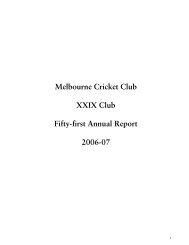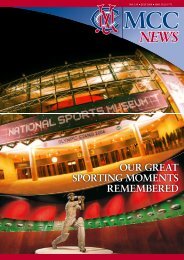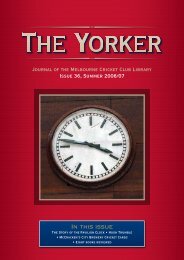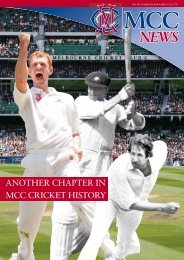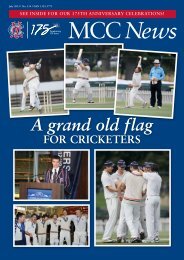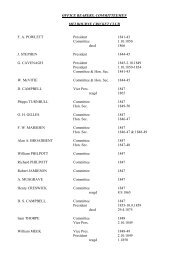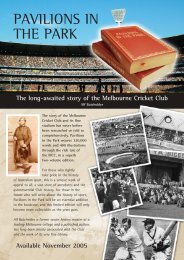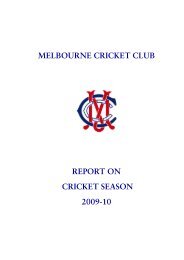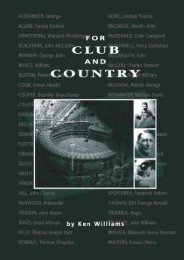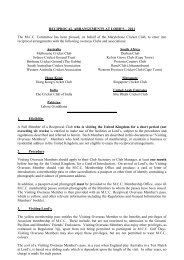Issue 42: Spring 2010 - Melbourne Cricket Club
Issue 42: Spring 2010 - Melbourne Cricket Club
Issue 42: Spring 2010 - Melbourne Cricket Club
You also want an ePaper? Increase the reach of your titles
YUMPU automatically turns print PDFs into web optimized ePapers that Google loves.
Late on November 15, Cugnet backed his words with "the most<br />
successful flight in the Commonwealth up to date" when he<br />
"soared" across the Altona property of MCC member (and VRC<br />
committeeman) William Henry Croker. After taxiing down the<br />
paddock, "the aeroplane slipped forward, dipped, then rose, and<br />
shot up to a height of 30ft." Much excitement followed:<br />
Back over the course it had just traversed it came as steadily<br />
as a soaring eagle. The splutter of the engine came nearer,<br />
and as he passed over the heads of the spectators Mr. Cugnet<br />
shot up still higher. In answer to the ringing cheers that<br />
greeted his successful flight, the aviator waved a hand, then<br />
sped on in the direction of Williamstown.After travelling a<br />
mile in under two minutes the aviator took a turn to the north,<br />
then came back again along a two-mile course, during which<br />
he reached the height of between 100ft. and 200ft. Turning<br />
gracefully a mile away to the west, Mr. Cugnet soared over a<br />
clump of trees, swooped down and cleared a fence, and then<br />
coming back to the middle of the paddock again ended his<br />
brilliantly successful flight by landing safely.<br />
After "a continuous flight of seven minutes" that covered "a<br />
distance of slightly over six miles", the Frenchman had landed<br />
"with all the Australian aviation records in his possession." 12<br />
Cugnet's achievement aroused enormous interest, leading to the<br />
promise of "a public trial of the aeroplane" on the Altona Estate<br />
on Saturday November 26. The occasion would also boast a<br />
military band and several refreshment marquees.<br />
The Victorian Railways and a steamship company made "special<br />
arrangements … for the carrying of visitors to the aerodrome."<br />
The Argus noted that the flight would be "under the patronage<br />
of both the Federal and State Ministry, and other distinguished<br />
citizens”. In addition, Glen's music warehouse offered a hundred<br />
tickets for the vice-regal reserve at a guinea each.<br />
Thousands flocked to Altona "to witness what was announced<br />
as the first public air flight in Victoria". Since the occasion was<br />
regarded "as of such importance as to warrant the christening<br />
of the flyer", William Morris Hughes was invited to perform<br />
the honours. Naming the aircraft "Australia", the acting Prime<br />
Minister "smashed a bottle of champagne, which poured over<br />
himself and he splashed the machine with a few drops."<br />
Unfortunately, as the breeze changed from "a light southerly<br />
into a sharp wind coming in freshening gusts", Cugnet decided<br />
that "the wind was so strong that any attempt to fly would have<br />
been to risk serious injury to the only machine … we have in<br />
Australia." The result was that the crowd became "bad tempered<br />
and sarcastic". Amid "fears for the safety of the machine", Cugnet<br />
reminded the press that he was "not a showman". Instead, his<br />
purpose was "to establish a school of aviation" in Australia.<br />
Nevertheless, he promised "another attempt within a week." 13<br />
The forthcoming Austral Wheel Race therefore presented an<br />
ideal opportunity for Cugnet to advance his cause. On November<br />
29, the MCC committee discussed a letter from Mr McCullagh,<br />
secretary of the <strong>Melbourne</strong> Bicycle <strong>Club</strong>, about the "ascent" of<br />
the Blériot on both days of the Austral Wheel Race.<br />
When asked back in October "to approve of the use of the Ground<br />
for Aeroplane flights", the club had been reluctant to agree "without<br />
further information". Now, by a margin of one vote, and with<br />
the demand for "a proper guarantee", the committee gave their<br />
permission. A day later, the MBC announced that Gaston Cugnet,<br />
"the Blériot flier" would give a display at the MCG on December 3.<br />
Though the promoters would accept no responsibility "should<br />
the weather conditions be unfavourable", an accompanying<br />
advertisement promised "The most sensational flight ever<br />
attempted in any part of the universe”. Intending spectators were<br />
also assured that Monsieur Cugnet was "most anxious" not to<br />
disappoint the public, for he "feels that his reputation as an AVIATOR<br />
is at stake." 14<br />
The Frenchman had more than his reputation "at stake". Though<br />
the dignitaries assembled at Altona would have understood<br />
his reasons for not taking to the air, his failure to fly had not<br />
improved prospects for the sale of Blériot machines to the<br />
Australian government. Another such episode would only further<br />
damage the interests that had sent him to Australia.<br />
Awaiting the Flight.<br />
On the first afternoon of the Austral, the crowd of at least 10,000<br />
enjoyed "a mild breeze from the south". As the Argus observed,<br />
"probably not a hundredth of them considered that the breeze …<br />
would be an obstacle to the aviation display." In such conditions, a<br />
common remark among the spectators was, "If the thing can't go<br />
up on a day like this, what is the use of it?" Around 5.30, with the<br />
cycling events completed, signs of impatience appeared:<br />
"Come on, monsieur!" "Let her go!" shouted men at the eastern<br />
end of the enclosure, to which the aeroplane was nearest.<br />
In some quarters, "a grumble of discontent" could be heard. By six<br />
o'clock, conditions had worsened, with the flag over the Pavilion<br />
floating "well out in the breeze". In these early years of aviation,<br />
wind was a fearsome enemy for pilots. In a frail Blériot, the risk<br />
could certainly not be ignored. (In 1927, after his epic transatlantic<br />
flight, Charles Lindbergh would tell Monsieur Blériot that he<br />
"wouldn't go up in your aeroplane for even one minute.") 15<br />
Nevertheless, windy though it was, Cugnet decided to fly. Though<br />
he later admitted that "it would be dangerous", he "was anxious<br />
not to disappoint the spectators" and he simply had to seize this<br />
precious opportunity to display his monoplane's merits. At about<br />
6.30, to the strains of La Marseillaise, he appeared on the arena.<br />
Usually, Cugnet "had a stern, sad expression" 16 but he was now<br />
skipping "along like a school girl". The Blériot's engine was<br />
started, and soon the aeroplane was running forward "on its three<br />
pneumatic tyred wheels towards the western end of the enclosure":<br />
After wheeling for about 40 yards, it rose into the air. But it had<br />
flown only some 40 yards at a height of about 15ft., when it<br />
wheeled to the left, stopped, and alighted again on the grass …<br />
The monoplane was then taken back to the eastern end of the<br />
arena, "and again faced westward":<br />
This time the aeroplane ran on its wheels to within about<br />
80 yards of the western boundary of the enclosure, heading<br />
outward for a gap between the new members' stand and the<br />
20 The Yorker - <strong>Spring</strong> <strong>2010</strong>



